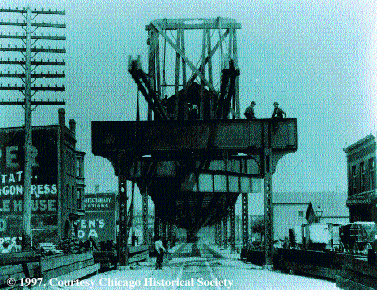
The University of Chicago Magazine
February 1997

Continued

Another Yerkes legacy: As the observatory neared completion, the Loop Elevated arose.
he and the University needed to find the $16,000 required to buy the disks.
On October 4, 1892, Harper and Hale visited Yerkes in his office at 444 North Clark Street. Similar scenes had been enacted throughout history. Impoverished scholars have often sought the patronage of wealthy aristocrats; no less a figure than Galileo required the financial support of Cosimo II de' Medici, the grand duke of Tuscany. Only in this instance the scholars weren't so poor and the prospective patron wasn't an aristocrat, though he'd been dubbed a "baron" of a different sort by the press. Yerkes nonetheless conceived of himself as a latter-day Medici and tried to live like one. He furnished his $1.5-million mansion on New York City's Fifth Avenue with a marble staircase, a conservatory complete with flitting birds, and a gallery full of European art treasures, and later built a second mansion a few blocks away for his favorite mistress.
Harper and Hale shrewdly appealed to Yerkes' considerable ego in order to obtain his financial support for their project. This would not be just any telescope, the scholars argued, it would be the world's largest telescope. For a man who always desired the biggest and best of everything, this proposal naturally held allure. The cost of building the telescope itself was brought up, but Hale seems not to have mentioned the matter of the observatory building and its cost--a figure that would substantially increase Yerkes' bill.
Perhaps the astronomer simply assumed the magnate would also finance the building. Or, more likely, he feared that Yerkes' knowledge of its total cost might doom the project. In any case, Yerkes indicated a willingness to fund the telescope. Once safely outside the magnate's office, Harper excitedly gave vent to his true feelings: "I'd like to go on top of a hill and yell!"
Writing to a friend a few days after this meeting, Harper had nothing but praise for Yerkes. "The enterprise will cost Mr. Yerkes certainly half a million dollars," he wrote, apparently in the belief he'd been given a blank check. "He is red hot and does not hesitate on any particular. It is a great pleasure to do business with such a man." But when he learned the true cost of the
project, Yerkes did hesitate. While certainly willing to finance a telescope, he had never planned on bankrolling a complete observatory building.
Unfortunately for the tycoon (and fortunately for science), Hale leaked to the press a greatly exaggerated account of Yerkes' generosity, and on October 12 news stories trumpeted the "princely donation." The trap had been sprung. In a December 5 letter to Harper, Yerkes agreed "to add to my gift, an observatory necessary to contain the instrument." Immortality did not come cheap.
Yerkes' generosity only briefly silenced most of his critics. The Evening Journal felt that it was "in the natural order of events" for Chicago to possess the world's largest telescope. "Chicago should have, and generally gets, the best of everything," the newspaper declared. The Daily Inter Ocean outdid the other newspapers in its praise of Yerkes and Sidney Kent, who funded a chemistry lab for the University. "What Lorenzo the Magnificent did for art in Florence, Kent and Yerkes, each in his own way, are doing for science in Chicago," the Inter Ocean puffed.
The Chicago Times, owned by exMayor Carter Harrison, Sr., refused to add to the cheers. "The astronomical beneficence of Mr. Yerkes does not excuse his street railway's shortcomings any more than the educational liberality of Mr. Rockefeller justifies the methods of the Standard Oil Company," the Times sneered. "It begins to look
Continue reading "ASTRONOMICAL FIGURES"
Go to:
- INVESTIGATIONS
- CHICAGO JOURNAL
- EVENTS
- LETTERS
- CHICAGOPHILE
- Feature story, "LIFE SUPPORT"
- Feature story, "Brushes with perfection"
- Feature story, "Opening Chapters"
- Feature story, "Astronomical Figures"
- CLASS NEWS
- DEATHS
- BOOKS BY ALUMNI
- IN THE CLUBS
Return to February 1997 Table of Contents